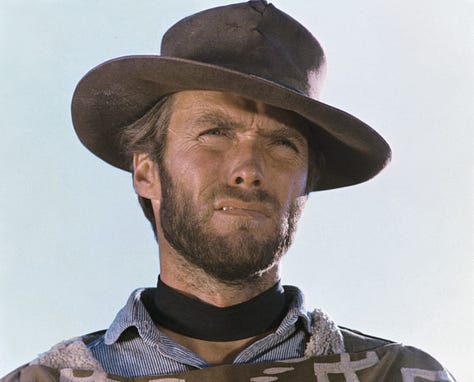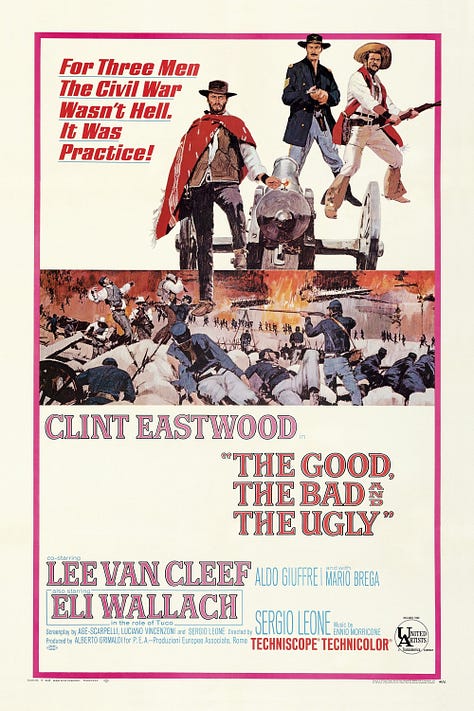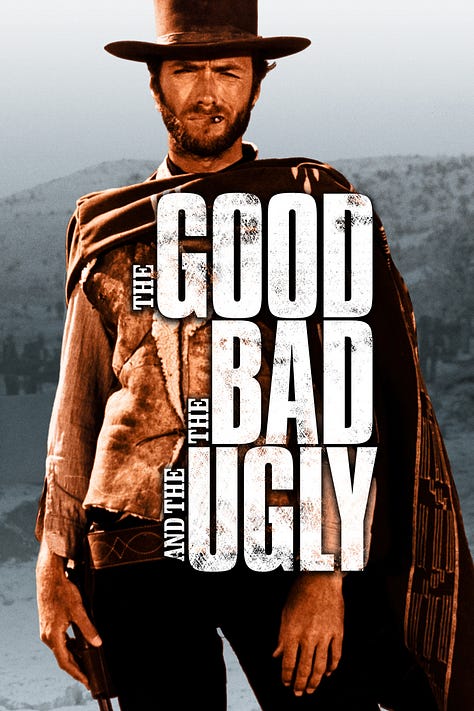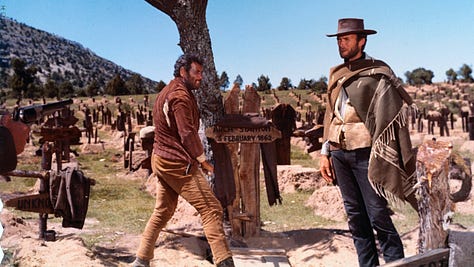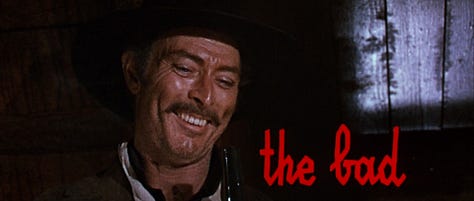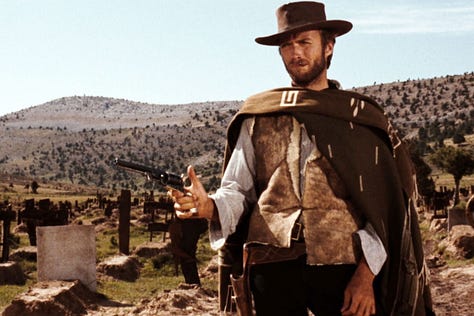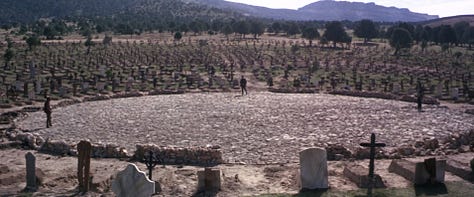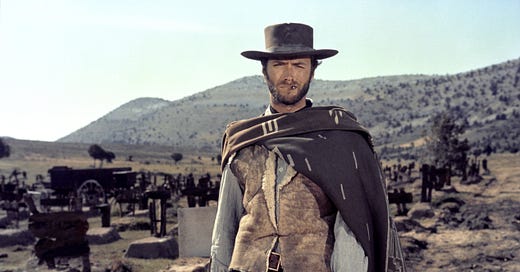THE GOOD, THE BAD AND THE UGLY
1966 • Sergio LeoneCast: Clint Eastwood, Lee Van Cleef, Eli Wallach, Aldo Giuffrè, Antonio Casas, Rada Rassimov, Aldo Sambrel, Enzo Petito, Luigi Pistilli, Livio Lorenzon
Screenplay: Agenore Incrocci, Furio Scarpelli, Luciano Vincenzoni, Sergio Leone
Cinematography: Tonino Delli Colli
Music: Ennio Morricone
Producer: Alberto Grimaldi
Produzioni Europee Associate/United Artists
You see, in this world there's two kinds of people, my friend: Those with loaded guns and those who dig. You dig.
The Good, the Bad and the Ugly is the definitive Spaghetti Western. Set against the backdrop of the American Civil War, the film follows three morally ambiguous characters—Blondie, "The Good" (Clint Eastwood), Angel Eyes, "The Bad" (Lee Van Cleef), and Tuco, "The Ugly" (Eli Wallach)—as they embark on a quest to find buried Confederate gold. The story begins with Blondie and Tuco exploiting the bounty reward system: Blondie turns in Tuco for the reward money, but before he can be hanged, Blondie saves him in a clever ruse. After both men discover information about a hidden treasure, the two turn on each other. However, both men end up needing the other to find the gold and an uneasy and untrustworthy alliance forms. Working together, not always willingly, they embark on an epic quest. Meanwhile, Angel Eyes, a ruthless mercenary, learns about the treasure and sets out on his own mission to locate it. A three-way game of cat and mouse in Italy…er, the “Old West,” ensues, becoming one of the great classic Spaghetti Westerns.
Spaghetti Westerns emerged in the mid-20th century, challenging traditional American Western conventions. For those who have never seen one, a Spaghetti Western is a subgenre of the Western, produced and directed by Italian filmmakers. Italian filmmakers were greatly influenced by the westerns, and using Italy’s similar landscapes, made their own epic versions, sometimes using American stars. These films, like The Good, the Bad and the Ugly often feature stylized violence, morally ambiguous characters, and a distinctive blend of intense close-ups and sweeping landscapes, with epic, guitar-laden soundtracks. In this film, directed by Sergio Leone, the trio of characters—Blondie, Angel Eyes, and Tuco—exemplify the genre's focus on antiheroes navigating a harsh, lawless landscape. The film is actually the third in a trilogy unofficially/officially named “The Man with the No Name” trilogy (or also the “Dollars” trilogy), a series of three Spaghetti Western films directed by Leone, all featuring Clint Eastwood in the lead role. While Eastwood's character is often referred to as "The Man with No Name," he is not the same character in each film. Though the characters Eastwood portrays in the trilogy are distinct, they share common traits, such as being morally ambiguous, resourceful, and quick with a gun. These films are celebrated for revolutionizing the Western genre, infusing it with the distinctive style of Leone, along with Ennio Morricone's iconic musical scores. While I haven’t written entries for the other two films in the trilogy, A Fistful of Dollars and For a Few Dollars More, there is no continuing story, so it matters not in what order you watch the films.
The music in The Good, the Bad and the Ugly is nothing short of perfection. Ennio Morricone's musical genius paired with Sergio Leone's exceptional direction creates an unparalleled experience. It’s an epic theme that lingers in your mind. You’ve heard the main title, even if you think you haven’t. The iconic whistling and “waa waa waa” is etched in your mind from pop culture references aplenty. Morricone's score is an integral part of the narrative, seamlessly intertwining with the characters. The greatest piece is “Ecstasy of Gold", which plays during Tuco's desperate sprint through a graveyard, followed by the emotive "Il triello,” which accompanies the showdown. Said showdown, framed by that unforgettable score, elevates the film to a level of goosebump-inducing emotion that remains unmatched.
Indeed, The Good, the Bad, and the Ugly is a long, three-hour film, but it maintains a high level of tension throughout the runtime. Sergio Leone's direction, coupled with Morricone's evocative score, and the charisma of the three leads, never allows you to be bored. The film is loaded with intrigue, plot twists, and the constant evolution of characters' motivations. Leone's use of deliberate pacing and intense close-ups adds to the tension, making even the quieter moments significant. Whether it's a subtle exchange of glances or a drawn-out standoff, the film keeps you, to use an old cliche, on the edge of your seat. There is never a dull moment.
Lee Van Cleef is absolutely sinister as Angel Eyes, or “The Bad”, establishing the character from his first frame on film as one of the most memorable in Leone’s oeuvre, outmatched only by Henry Fonda’s Frank in Once Upon a Time in the West. Van Cleef is chillingly intense, a formidable foe for our other two protagonists. Van Cleef’s character is paradoxically named: Angel Eyes' gaze is cold, calculating, and soulless. Van Cleef's own piercing eyes convey ruthlessness and cunning. Angel Eyes can read people and situations with unnerving precision. Whether negotiating or committing acts of violence, Angel Eyes maintains a calm and detached demeanor that adds to his aura of menace. Angel Eyes is characterized by his relentless pursuit of his goals, in this case the capture of Tuco and Blondie. Angel Eyes interrogates with a level of cruelty that demonstrates his lack of empathy. The use of close-up shots intensifies Van Cleef's (and his character’s) eyes, allowing you to witness the subtle shifts in expression that reveal Angel Eyes' calculating mind.
Eli Wallach's portrayal of Tuco is perhaps my favorite. Wallach injects a dynamic energy that steals the movie, much as Tuco attempts to steal the gold at the end of the film. Tuco is a co-protagonist alongside Blondie, but he is also a villainous bandit. He doesn’t have many redeeming characteristics but you can’t help but find him unnervingly loveable. Tuco is a complex character, and Wallach navigates the intricacies with finesse. He balances comedic charm with moments of genuine pathos, creating a character who is both unpredictable and relatable. No scene better exemplifies this than when he reunites with his estranged brother. But every time you feel sympathy for Tuco, or you laugh at something genuinely funny he says or does, he almost immediately pulls some cheap backstab, betraying Blondie and the audience, yet again. Tuco, for all his buffoonery, is also deceptively cunning. One of the best scenes involves him tracking down Blondie, merely by following a trail of cigar butts all over the desert. Tuco's presence is particularly felt in the film's memorable set pieces, such as the previously mentioned graveyard shootout, where Wallach's physicality and expressiveness shine.
But of course the star of the film is a very young, very handsome Clint Eastwood. (As an aside, have you seen his son, actor Scott Eastwood? Dead ringer for dad.) While he does have formidable acting co-stars Eastwood’s enigmatic Blondie undeniably emerges as an iconic character. Eastwood's Man with No Name not only contributes significantly to the film but also sets the stage for roles that would define his career for decades to come, including Dirty Harry Callahan. Blondie's cool reserve becomes particularly noticeable amidst the formidable performances of Lee Van Cleef's Angel Eyes and Eli Wallach's Tuco. In scenes where tension is palpable, Eastwood's understated yet intense demeanor stands out. His stoic expression and deliberate, measured movements create a character who is not only mysterious but also exudes confidence. Once again, I come back to the film's climax: the three-way standoff in the graveyard. Blondie remains a study in calm calculation. Eastwood's iconic squint and steely gaze make Blondie an unforgettable figure amid chaos. Eastwood's use of silence as a powerful tool adds to Blondie's mystique. His economy of words and subtle gestures speak volumes. He’s a perfect counterbalance to his on-again-off-again partner Tuco. The contrast between Tuco's frenetic energy and Blondie's composed demeanor highlights Eastwood's ability to command attention without overt theatrics. The dynamic between the two characters becomes central to making the story work.
The Good, The Bad and The Ugly is the definitive spaghetti western. It’s operatic. It’s violent. It’s funny. It’s action-packed. While you may have your favorites, and I do too, no other spaghetti western has achieved its iconic status. If this is your first experience with one, I would highly recommend diving deeper into the rest of the Dollars trilogy and Leone’s work, specifically Once Upon a Time in the West.
When you have to shoot, shoot. Don't talk.
Notable Awards & Accomplishments
IMDB Top 250 - #10 (as of this writing)
Laurel Award Nominee: Action Performance - Clint Eastwood
Streaming: DirecTV, Cinemax
Digital Rental/Purchase: Available at most major digital retailers
Physical Media: Available on 4K, Blu-Ray and DVD
